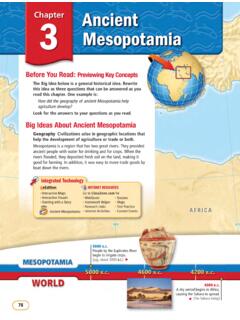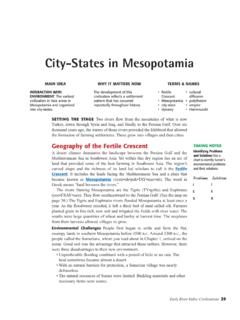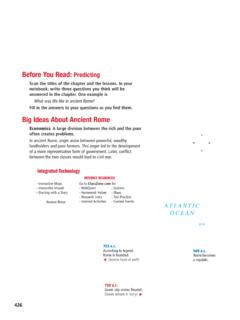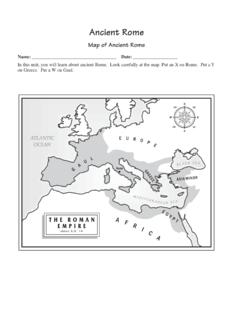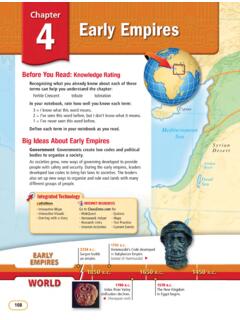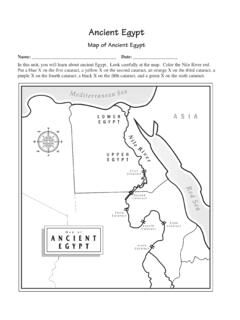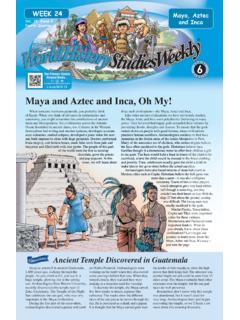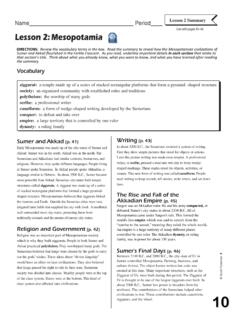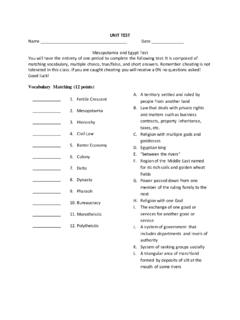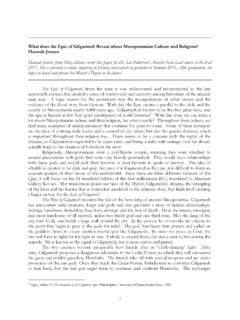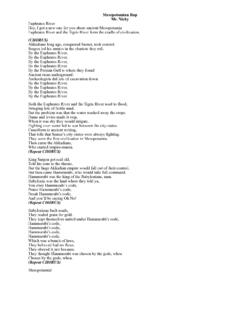Transcription of City-States in Mesopotamia
1 Early River Valley Civilizations29 MAIN IDEAWHY IT MATTERS NOWTERMS & NAMESINTERACTION WITHENVIRONMENTThe earliestcivilization in Asia arose inMesopotamia and organizedinto development of thiscivilization reflects a settlementpattern that has occurredrepeatedly throughout history. FertileCrescent Mesopotamia city-state dynasty culturaldiffusion polytheism empire Hammurabi1 Identifying Problemsand SolutionsUse achart to identify Sumer'senvironmental problemsand their NOTESSETTING THE STAGETwo rivers flow from the mountains of what is nowTurkey, down through Syria and Iraq, and finally to the Persian Gulf. Over sixthousand years ago, the waters of these rivers provided the lifeblood that allowedthe formation of farming settlements. These grew into villages and then cities. Geography of the Fertile CrescentA desert climate dominates the landscape between the Persian Gulf and theMediterranean Sea in Southwest Asia.
2 Yet within this dry region lies an arc ofland that provided some of the best farming in Southwest Asia. The region scurved shape and the richness of its land led scholars to call it the FertileCrescent. It includes the lands facing the Mediterranean Sea and a plain thatbecame known as Mesopotamia (MEHS uh puh TAY mee uh). The word inGreek means land between the rivers. The rivers framing Mesopotamia are the Tigris (TY grihs) and Euphrates(yoo FRAY teez). They flow southeastward to the Persian Gulf. (See the map onpage 30.) The Tigris and Euphrates rivers flooded Mesopotamia at least once ayear. As the floodwater receded, it left a thick bed of mud called silt. Farmersplanted grain in this rich, new soil and irrigated the fields with river water. Theresults were large quantities of wheat and barley at harvest time.
3 The surplusesfrom their harvests allowed villages to ChallengesPeople first began to settle and farm the flat,swampy lands in southern Mesopotamia before 4500 Around 3300 , thepeople called the Sumerians, whom you read about in Chapter 1, arrived on thescene. Good soil was the advantage that attracted these settlers. However, therewere three disadvantages to their new environment. Unpredictable flooding combined with a period of little or no rain. Theland sometimes became almost a desert. With no natural barriers for protection, a Sumerian village was nearlydefenseless. The natural resources of Sumer were limited. Building materials and othernecessary items were in MesopotamiaSolving Problems Through OrganizationOver a long period of time, the peopleof Sumer created solutions to deal with these problems. To provide water, they dug irrigation ditches that carried river water to theirfields and allowed them to produce a surplus of crops.
4 For defense, they built city walls with mud bricks. Sumerians traded their grain, cloth, and crafted tools with the peoples of themountains and the desert. In exchange, they received raw materials such asstone, wood, and activities required organization, cooperation, and leadership. It took manypeople working together, for example, for the Sumerians to construct their largeirrigation systems. Leaders were needed to plan the projects and supervise the dig-ging. These projects also created a need for laws to settle disputes over how landand water would be distributed. These leaders and laws were the beginning oforganized government and eventually of civilization. Sumerians Create City-StatesThe Sumerians stand out in history as one of the first groups of people to form acivilization. As you learned in Chapter 1, five key characteristics set Sumer apartfrom earlier human societies: (1) advanced cities, (2) specialized workers, (3) com-plex institutions, (4) record keeping, and (5) improved technology.
5 All the laterpeoples who lived in this region of the world built upon the innovations ofSumerian 2 IRAQIRANKUWAITSAUDI ARABIAP resent-day Persian GulfIn 2500 , the Persian Gulf was larger than it is today. Over time the Tigris and Euphrates have joined together and filled in this shallow area. The ancient coastline is shown above with a blue CrescentSumerDirection of flowof the Tigris andEuphratesMESOPOTAMIAANATOLIAEGYPTSUME RAKKADSYRIANDESERTARABIAN RiverCaspianSeaPersianGulfTigrisRiverEup hratesRiverRedSeaNileRiver50 E40 E30 E40 N30 NKishLagashUrUrukUmmaBabylonAgade0 250 Miles 0 500 Kilometers The Fertile Crescent, 2500 SKILLBUILDER: Interpreting are the Tigris and Euphrates River valleys found? is the most likely cause of the change in the Persian Gulf coastline?SummarizingWhat are threesolutions to theenvironmental challenges ofMesopotamia?
6 By 3000 , the Sumerians had built a number of cities, each surrounded byfields of barley and wheat. Although these cities shared the same culture, theydeveloped their own governments, each with its own rulers. Each city and the sur-rounding land it controlled formed a city-state. A city-state functioned much as anindependent country does today. Sumerian City-States included Uruk, Kish,Lagash, Umma, and Ur. As in Ur, the center of all Sumerian cities was the walledtemple with a ziggurat in the middle. There the priests and rulers appealed to thegods for the well-being of the and Rulers Share ControlSumer s earliest governments were controlledby the temple priests. The farmers believed that the success of their crops dependedupon the blessings of the gods, and the priests acted as go-betweens with the addition to being a place of worship, the ziggurat was like a city hall.
7 (See page22 for a ziggurat.) From the ziggurat the priests managed the irrigation demanded a portion of every farmer s crop as time of war, however, the priests did not lead the city. Instead, the men of thecity chose a tough fighter who could command the city s soldiers. At first, a com-mander s power ended as soon as the war was over. After 3000 , wars betweencities became more and more frequent. Gradually, Sumerian priests and peoplegave commanders permanent control of standing armies. In time, some military leaders became full-time rulers. These rulers usuallypassed their power on to their sons, who eventually passed it on to their own a series of rulers from a single family is called a dynasty. After 2500 ,many Sumerian City-States came under the rule of Spread of CitiesSumer s City-States grew prosperous fromthe surplus food produced on their farms.
8 These surpluses allowedSumerians to increase long-distance trade, exchanging the extrafood and other goods for items they needed. By 2500 , new cities were arising all over the Fertile Crescent,in what is now Syria, northern Iraq, and Turkey. Sumeriansexchanged products and ideas, such as living in cities, with neigh-boring cultures. This process in which a new idea or a productspreads from one culture to another is called cultural CultureThe belief systems, social structure, technology, and arts of theSumerians reflected their civilization s triumph over its dry andharsh Religion of Many GodsLike many peoples in the FertileCrescent, the Sumerians believed that many different gods con-trolled the various forces in nature. The belief in more than one godis called polytheism(PAHL ee thee IHZ uhm).
9 Enlil, the god ofstorms and air, was among the most powerful gods. Sumeriansfeared him as the raging flood that has no rival. Demons knownas Ugallu protected humans from the evil demons who caused dis-ease, misfortune, and described their gods as doing many of the same thingshumans do falling in love, having children, quarreling, and so the Sumerians also believed that their gods were both immortaland all-powerful. Humans were nothing but their servants. At anymoment, the mighty anger of the gods might strike, sending a fire, aflood, or an enemy to destroy a city. To keep the gods happy, the Iku-Shamagen,King of Mari, acity-state inSumer, offersprayers to CausesHow did mili-tary leaders gainpower in the City-States ?Early River Valley Civilizations3132 Chapter 2 Sumerians built impressive ziggurats for them and offeredrich sacrifices of animals, food, and worked hard to earn the gods protection inthis life.
10 Yet they expected little help from the gods afterdeath. The Sumerians believed that the souls of the deadwent to the land of no return, a dismal, gloomy placebetween the earth s crust and the ancient sea. No joy awaitedsouls there. A passage in a Sumerian poem describes the fateof dead souls: Dust is their fare and clay their food. Some of the richest accounts of Mesopotamian mythsand legends appear in a long poem called the Epic ofGilgamesh. (See a selection from the Gilgamesh epic onpage 83.)Life in Sumerian SocietyWith civilization came the begin-ning of what we call social classes. Kings, landholders, andsome priests made up the highest level in Sumerian merchants ranked next. The vast majority of ordi-nary Sumerian people worked with their hands in fields andworkshops. At the lowest level of Sumerian society were theslaves.
